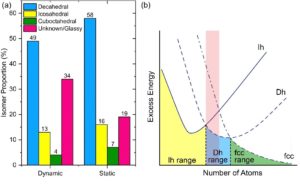Face-centered cubic (fcc) metals, such as Au and Ag, usually adopt a packed crystal structure in bulk. However, the equilibrium structure could differ when only a handful of atoms compose a nanocluster. Theories have predicted that particles less than a few nanometers would favor a decahedral packing with a five-fold symmetry; when even fewer atoms are present, say less than two hundred, a 20-fold icosahedral packing would become the lowest-energy configuration. Such fluctuations of the nuclei/seeds may have played a critical role in defining the shape of colloidal nanoparticles in many wet chemical syntheses.
In recent work, a cross-institutional team led by Richard E. Palmer and Thomas J. A. Slater reported the direct observation of such fluctuations on a nearly second-by-second basis. The team synthesized Au nanoclusters containing 309±15 atoms on an amorphous carbon film through mass-selected magnetron sputtering. Subsequently, aberration-corrected scanning transmission electron microscopy (STEM) was employed to track the atomic structures of Au nanoclusters with a frame rate of 0.4–0.7 per second (Fig. 1). To identify the cluster type in each frame, the team compared them to a collection of simulated images with different cluster structures and tilt angles. The clusters exhibited highly dynamic switching between decahedral, icosahedral, and single-crystalline structures under the electron beam, which is sufficiently strong to overcome the energy barriers between such transitions.

Fig. 1 Au309±15 clusters fluctuating under the electron beam. High-angle annular dark field (HAADF) imaging on an aberration-corrected scanning transmission electron microscope (STEM) resolved the atomic structure of these Au nanoclusters frame by frame. Adapted from the supporting data DOI: 10.5281/zenodo.10522408, CC-BY 4.0.
Notably, the authors showed that the Au309±15 clusters favor the decahedral structure the most, followed by icosahedral and then single-crystalline structures (Fig. 2a). This result is consistent with the probabilities obtained from a snapshot of an ensemble. In theory, the lower-energy structures would have a higher probability of appearance. The ranking of isomeric preferences observed in this study indicates that the cluster size is within a range where the energy ranks in fcc > icosahedral > decahedral (Fig. 2b). Taken together, this work illustrates the possibility of atomic-resolution electron microscopy, when combined with image simulations, to track the isomeric evolution of metal nanoclusters and may shed light on how we understand and regulate nanostructures with atomic precision.

Fig. 1 (a) Histogram of isomer abundances from dynamic movies compared with a static image of a cluster ensemble. Reproduced from DOI: 10.1039/D3NH00291H with permission from the Royal Society of Chemistry. (b) Schematic energy landscape of cluster structures for fcc metals. A red shade indicates the cluster size range in the current study. Ih: icosahedral. Dh: decahedral. Adapted from DOI: 10.1002/anie.202015166 with permission from Wiley-VCH.
To find out more, please read:
Frame-by-frame observations of structure fluctuations in single mass-selected Au clusters using aberration-corrected electron microscopy
Malcolm Dearg, Cesare Roncaglia, Diana Nelli, El Yakout El Koraychy, Riccardo Ferrando, Thomas J. A. Slater, and Richard E. Palmer
Nanoscale Horiz., 2024, 9, 143-147
About the blogger

Jingshan S. Du is a Washington Research Foundation Postdoctoral Fellow at Pacific Northwest National Laboratory and a member of the Nanoscale Horizons Community Board. His research spans crystal formation and transformation pathways, in situ electron microscopy, and hybrid organic/inorganic nanostructures. Du received a Ph.D. in Materials Science and Engineering from Northwestern University in 2021. At Northwestern, he worked on complex nanoparticle systems, correlative electron microscopy of hybrid nanostructures, and nanoscale thermodynamics. Du received a Certificate for Management for Scientists and Engineers from Northwestern’s Kellogg School of Management in 2021 and a B.Sc. in Engineering from Zhejiang University Chu Kochen Honors College in 2015. You can follow him on Twitter @JingshanDu. The views expressed in this article do not necessarily reflect those of the author’s employer or the US government.
|










